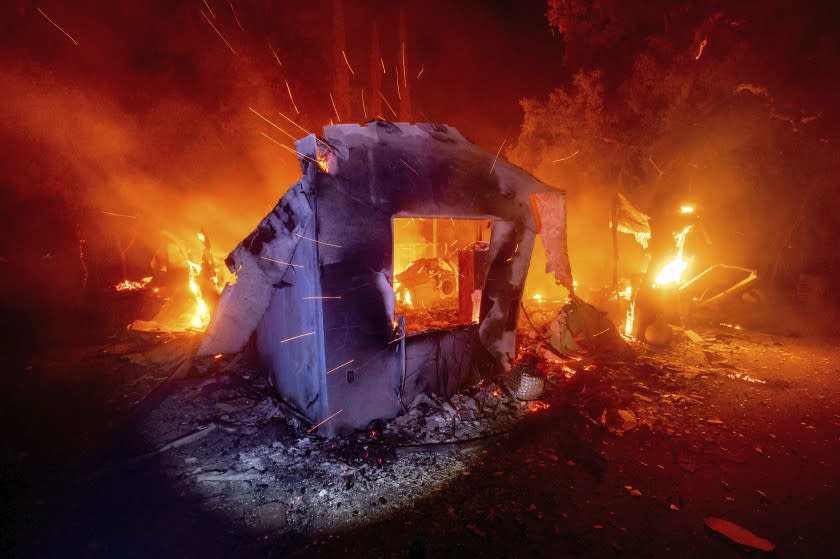Op-Ed: Concrete steps California can take to prevent massive fire devastation

California is on fire. So are Washington and Oregon. The American West, like Australia before it, is burning on an unprecedented scale. Tens of millions of Americans are choking on smoke.
Although there has been inevitable hand wringing over causes of ignition — downed power lines, gender-reveal parties — these factors didn’t create the larger crisis. Wildfires are inevitable in the West. Widespread devastation need not be.
The underlying causes are complex and varied. Climate change is a big one, of course. But so are more than a century of land-use practices that allowed communities to be built in harm’s way, and the flawed view that wildfires should be “fought” rather than lived with, managed and used.
We all need to support communities that are suffering and the firefighters struggling to contain wildfires across the state. But we also need to address the root causes of this crisis. We cannot firefight our way out of it.
California and the West need immediate investment in two areas. We need to make our communities more resistant to burning, and we need a more effective approach to land management, one that welcomes low-intensity, “good” fire as a means of preventing catastrophic megafires. This is not news. Federal and state land managers and firefighters have been saying this for at least 50 years, to little avail.
When we know what to do but haven’t done it, often it helps to make the task someone’s principal mission. It’s time to seriously evaluate whether our firefighting and disaster agencies — Cal Fire, the California Office of Emergency Services, the U.S. Forest Service and the Federal Emergency Management Agency — have the bandwidth to adequately prepare and defend our communities, given the increasing magnitude and frequency of climate-fueled disasters. Perhaps, instead, we need a new state agency altogether, one whose express purpose is to reduce wildfire risks to Californians.
Successful wildfire preparedness begins with a clear strategy and accountability for outcomes. As it stands, California has neither. We have outsourced preparedness to our emergency response agencies, whose main priority is fire suppression and disaster recovery, not risk reduction. It’s not a shock that we aren’t getting the results we so urgently need.
A new state agency could set annual and long-term goals on several key fronts: fire hardening individual homes in high-risk areas, safeguarding communities as a whole, and reintroducing prescribed burns in wildlands. Targets need to be established at a scale large enough to have an impact, not according to political judgments based on how much money is available.
For fire hardening homes, a reasonable goal would be 100,000 homes per year, selected from the roughly 1 million that are currently located in the highest-risk zones. Homeowners who can afford it should pay for their share of costs, while those who cannot should be eligible for financial assistance.
To safeguard communities, every community in a high-risk area needs to have a science-based plan for minimizing vulnerabilities to wildfire. These risk-reduction plans would ideally include timelines for reducing fuel loads along streets and creating critical buffers, such as the ambitious greenbelt zone currently under consideration in the town of Paradise. Each of these plans should outline a viable funding mechanism. Progress ought to be measured within five years.
To reduce massive fuel loads in wildlands, a new agency could rapidly expand the state’s use of prescribed fires. An appropriate starting goal would be 1 million acres per year, as was recommended in a 2018 report by the Little Hoover Commission. Vast swaths of land would need to be prepared for, and then treated with, prescribed burns.
These measures would be labor-intensive. But, unlike higher insurance premiums, secure funding for such investments would create thousands of needed jobs — for contractors, landscape crews and prescribed fire teams, among others.
A wildfire preparedness agency could take on other big-picture objectives. It could work on reducing threats not only to lives and homes, but to public health and economic well-being. It could form partnerships with disaster response agencies, local governments and private landowners. And it could work with planning agencies to ensure any new housing developments are built with wildfire risks in mind. It could also more proactively incorporate the expertise of Native American tribes that have been managing California landscapes with fire for thousands of years.
Perhaps most importantly, this new agency would be accountable to the governor and the Legislature if it failed to achieve its goals.
We don’t hesitate to create departments for police, firefighters and public schools. We have these entities because they provide an essential public service. At this point, in California, wildfire preparedness is no different.
Michael Wara is director of the climate and energy policy program at Stanford University’s Woods Institute for the Environment and serves on the California Catastrophe Response Council. He previously served on the state’s Commission on Catastrophic Wildfire Cost and Recovery.

